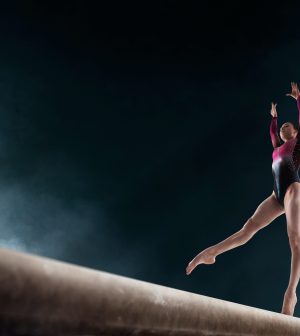- Skip Storing This Everyday Product in the Fridge Door
- Green Tea + B3 Pairing May Boost Brain Health
- Navigating Your Midlife Crisis: Embracing New Possibilities
- City Raccoons Showing Signs of Domestication
- Mapping the Exposome: Science Broadens Focus to Environmental Disease Triggers
- One Week Less on Social Media Linked to Better Mental Health
- Your Brain Changes in Stages as You Age, Study Finds
- Some Suicide Victims Show No Typical Warning Signs, Study Finds
- ByHeart Formula Faces Lawsuits After Babies Sickened With Botulism
- Switch to Vegan Diet Could Cut Your Greenhouse Gas Emissions in Half
Women’s Gymnastics Brings High Risk for Concussion

Gymnasts make it look easy, but mastering those floor exercises and balance beam moves can take a toll on the brain.
Researchers studying preseason and regular season concussion rates in college sports found that women’s gymnastics led all others for its concussion rate in the preseason. The rate was 50% higher even than that for college football players.
Unlike soccer and football, gymnastics hasn’t historically been considered a high concussion risk, said lead researcher Steven Broglio, director of the University of Michigan Concussion Center.
“Everybody worries about football, ice hockey and men’s and women’s soccer, but gymnastics is out there by themselves with a preseason injury risk that we didn’t expect to see,” Broglio said in a university news release. “We now need to look at how to improve the health and safety of the athletes.”
Researchers studied sport-related concussion rates for NCAA sports during the preseason practice period and regular season from the 2013-2014 year through the 2018-2019 year.
In the preseason, roughly nine gymnasts for every 10,000 athlete participations experienced concussion, while about six football players per 10,000 athlete participations experienced concussion during the preseason.
While the preseason sessions are practices only, the regular season includes practice and competition.
The findings were presented June 2 at the American College of Sports Medicine annual meeting in Denver. Such research is considered preliminary until published in a peer-reviewed journal.
Broglio said he doesn’t know the sport of gymnastics well enough to speculate on what caused the preseason spike. He said he does not believe coaches are being careless.
“It’s likely a situation where it’s an activity that’s been done for a long time and we just need to ask, ‘Do we really need to have the women engaging in this training activity knowing there is an increased risk for injury associated with it?’ Or, perhaps during the preseason, women are working on new routines so the risk of injury is higher with unfamiliar skills,” Broglio said.
Concussion research is lacking on female athletes, Broglio added.
“There is a very clear lack of science in the broader literature around women’s sports,” Broglio said. “We’re hoping research like this shines a light on the deficits in the literature and allows people to take a deeper dive to understand what’s going on, to improve outcomes.”
In this new study, the other results researchers found were as expected.
In the preseason, the top sports for concussion were gymnastics, football, men’s lacrosse, women’s volleyball, women’s basketball and women’s soccer.
That shifted in the regular season to women’s and men’s ice hockey, men’s wrestling, women’s soccer, men’s football and women’s field hockey.
“All sports carry some level of risk, and we should constantly be looking for ways to make sports safer,” Broglio said. “We want to optimize performance, but in a healthy and safe way.”
More information
The American Academy of Orthopaedic Surgeons has more on sports concussions.
SOURCE: University of Michigan, news release, June 5, 2023
Source: HealthDay
Copyright © 2025 HealthDay. All rights reserved.










